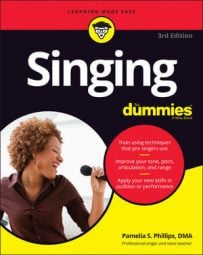Each section of a song must have a distinct feel or tone. To convey different tones in different sections, you need to make a change of thought to create a change of tone. Look through your song and determine how many sections it has.
You know it’s a new section because one of these things happens: A piano interlude (a solo section for the piano in between the vocal section) often leads to a new section, the music changes and adds different rhythms or moves to a new key, or the text changes and a new topic arises.
You can compare this study of your music to studying poetry. Each poem, or grouping of words, has a certain rhythm to it, called meter. When you know the meter, you can look farther to find the rhyme scheme. Knowing the rhyme scheme gives you a clue to how many sections the piece has.
The form of a song tells you how many sections you can expect to find.
Strophic, which is similar to a hymn, means that the same music is repeated for each section of text, or each stanza.
Two part AB means that two main sections may occur in order as AB or ABA, with the first section repeating. An example of an AABA song is the Flintstone’s theme; an AB example is “(Baby You Can) Drive My Car,” by The Beatles. You may think of other songs that fit because they have a verse and a chorus.
Through composed means that the entire piece is new, with no repeats of any sections in any stanza. Examples of through composed songs include “Yesterday,” by John Lennon and Paul McCartney, and “Stairway to Heaven,” by Led Zeppelin.
If a section repeats, speculate about what made the composer or lyricist repeat those words. What reason necessitates saying the same words again? Exploring those reasons may help you discover how to create changes in your tone by changing what you’re thinking.
You need to sing a repeated part differently the second time than you did the first time. (And if it repeats a third or even fourth time, each repetition needs to be distinct from the others.)
Finding the minimum number of sections to a song tells you the minimum number of changes.

